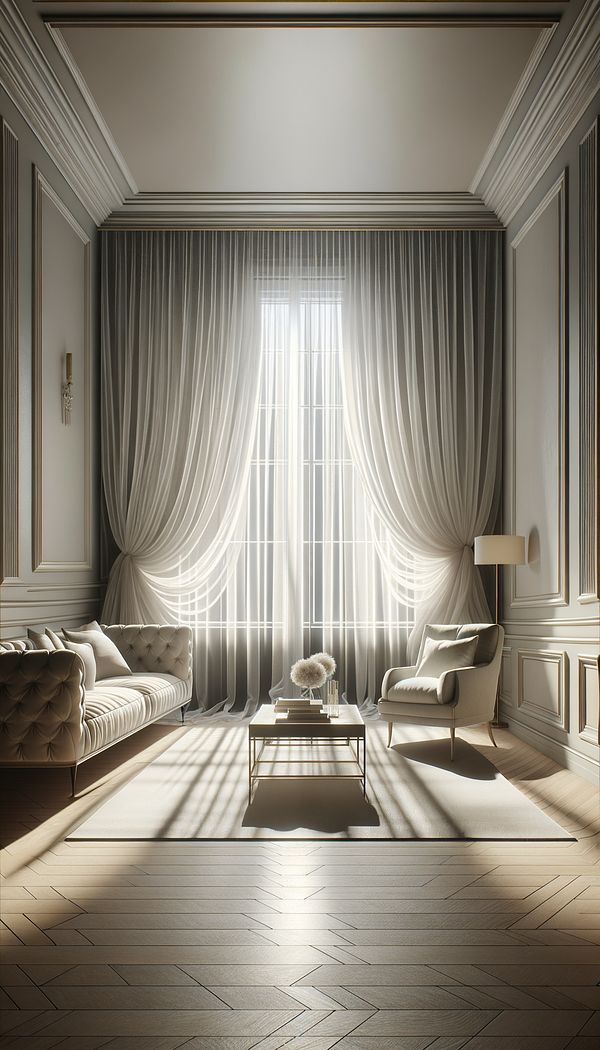What is Organdy?
Organdy is a lightweight, sheer, crisp fabric made from cotton or polyester.
Description
Organdy is a distinctive fabric renowned for its transparency, crispness, and lightweight nature. Made traditionally from cotton and sometimes from polyester for added durability, organdy holds a unique place within interior design and fashion due to its sheer quality and texture. This fabric is created through a process that involves heavily sizing the yarns prior to weaving, which gives organdy its characteristic stiffness and shimmering surface. Following the weaving process, the fabric undergoes a finish that helps retain its crispness even after washing.
In the realm of interior design, organdy is frequently used to infuse spaces with a touch of elegance and delicacy. Its translucency allows for the passage of light, making it ideal for window treatments that aim to offer privacy while still letting in natural sunlight. Furthermore, organdy can be dyed in a vast range of colors and printed with various designs, which adds to its versatility. Designers also appreciate organdy for its ability to hold shapes and create a sense of volume, making it a popular choice for decorative accents.
Usage
Organdy is often employed in interior design to create ethereal window treatments, such as curtains and sheers, that softly diffuse light and lend a subtle elegance to a room. It's also used for decorative purposes, in items like lampshades, table runners, and as a material for creating intricate decorative elements. Due to its sheer nature, organdy can make space feel airy and bright.
FAQs
-
Is organdy the same as organza?
No, organdy and organza are distinct fabrics. While they share a sheer quality, organdy is made from cotton or polyester, offering a firmer, crisper texture compared to the silk or synthetic filaments used in organza, which has a more fluid drape.
-
Can organdy be used for upholstery?
Due to its delicate and sheer nature, organdy is generally not recommended for upholstery applications as it may not withstand regular wear and tear. However, it can be used for decorative accents in upholstery projects.
-
How should organdy fabric be cared for?
Organdy, especially when made from cotton, should be gently hand washed or machine washed on a delicate cycle with cold water to retain its crispness and aired dried. Ironing may be required to maintain its smooth texture, but it should be done with caution, using a low to medium setting.
Practical Application
When incorporating organdy into your interior design projects, consider the space's function and the fabric's sheer nature. For window treatments, organdy can provide privacy while still allowing natural light to filter through, creating a luminous, airy feel. Remember, since organdy is lightweight and can fray, finishing the edges and using a liner can help enhance its durability. Additionally, playing with layered organdy in different colors can add depth and interest to your design.
-
Decorative Techniques322 articles
-
Window Treatments65 articles
-
Materials & Textiles360 articles
-
Color & Patterns154 articles
-
Textiles & Upholstery252 articles
-
LinenLinen is a textile made from the fibers of the flax plant.
-
EbenisteAn ebeniste is a highly skilled cabinetmaker who specializes in the art of fine furniture making.
-
ChambrayChambray is a lightweight cotton fabric with a plain weave and a slightly glossy surface.
-
CeramicCeramic refers to objects made from clay that have been shaped and then hardened by heat.
-
Receding ColorsReceding colors are hues that appear to fall back or retreat in a space, creating an illusion of depth and expanse.
